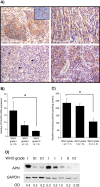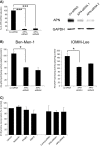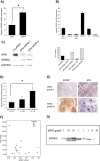Reduced activity of CD13/aminopeptidase N (APN) in aggressive meningiomas is associated with increased levels of SPARC
- PMID: 19236378
- PMCID: PMC8094747
- DOI: 10.1111/j.1750-3639.2009.00267.x
Reduced activity of CD13/aminopeptidase N (APN) in aggressive meningiomas is associated with increased levels of SPARC
Abstract
Meningiomas are the second most common brain tumors in adults, and meningiomas exhibit a tendency to invade adjacent structures. Compared with high-grade gliomas, little is known about the molecular changes that potentially underlie the invasive behavior of meningiomas. In this study, we examined the expression and function of the membrane alanyl-aminopeptidase [mAAP, aminopeptidase N (APN), CD13, EC3.4.11.2] zinc-dependent ectopeptidase in meningiomas and meningioma cell lines, based on its prior association with tumor invasion in colorectal and renal carcinomas. We found a significant reduction of APNmRNA and protein expression, as well as enzymatic activity, in high-grade meningiomas. While meningioma tumor cell proliferation was not affected by either pharmacologic APN inhibition or siRNA-mediated APN silencing, APN pharmacologic and siRNA knockdown significantly reduced meningioma cell invasion in vitro. Next, we employed pathway-specific cDNA microarray analyses to identify extracellular matrix and adhesion molecules regulated by APN, and found that APN-siRNA knockdown substantially increased the expression of secreted protein, acidic and rich in cysteine (SPARC)/osteonectin. Finally, we demonstrated that SPARC, which has been previously associated with meningioma invasiveness, was increased in aggressive meningiomas. Collectively, these results suggest that APN expression and enzymatic function is reduced in aggressive meningiomas, and that alterations in the balance between APN and SPARC might favor meningioma invasion.
Figures





References
-
- Carl‐McGrath S, Lendeckel U, Ebert M, Wolter AB, Roessner A, Rocken C (2004) The ectopeptidases CD10, CD13, CD26, and CD143 are upregulated in gastric cancer. Int J Oncol 25:1223–1232. - PubMed
-
- Carl‐McGrath S, Lendeckel U, Ebert M, Rocken C (2006) Ectopeptidases in tumour biology: a review. Histol Histopathol 21:1339–1353. - PubMed
Publication types
MeSH terms
Substances
LinkOut - more resources
Full Text Sources
Miscellaneous

